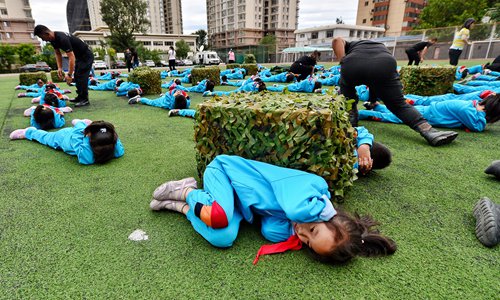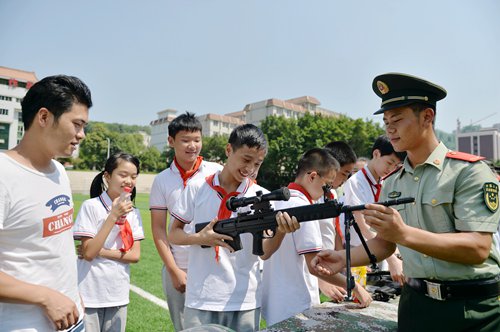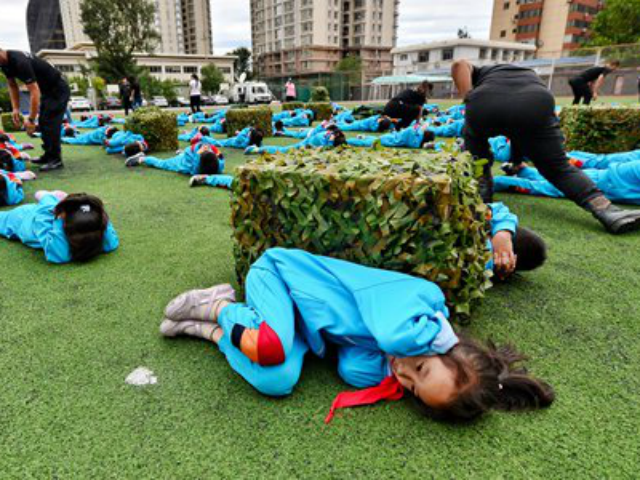Chinese citizens in Beijing, Shanghai, and other major population hubs throughout the country spent the weekend observing Nationwide National Defense Education Day, forced to practice air raid drills to know how to react to a military invasion.
China’s state propaganda outlets published photos of young children kneeling and hiding. The Global Times, one of the largest government newspapers in the country, published images of Young Pioneers, identifiable by their red scarves, learning to handle military-grade firearms. The Chinese military’s official website also posted images of the drills nationwide.


The Global Times reported that Communist Party officials sounded air raid alarms throughout Saturday to teach residents, students, and elderly alike, how to properly protect their lives in the event of an air invasion.
“The air defense warning drill was carried out in three parts, each spaced seven minutes apart. The first is the pre-alarm signal. The second is the air raid siren. The third is the all-clear siren,” the Times specified
A Chinese government official identified as Li Chunting told the Global Times that the purpose of forcing civilians to practice air raid defense was to “implement the civil air defense regulations and laws,” thus bringing more regimented government discipline into the lives of the individual whether or not they are members of the military.
In addition to morning exercises in Beijing, the Communist Party “arranged city-level evacuation drills Saturday in the business areas to improve the ability of white-collar workers to conduct air defense evacuations” in Shanghai. Separate drills for the disabled and elderly also occurred.
Chinese Communist Party leader Xi Jinping announced a year ago that he would implement a plan to build a “world-class military by 2050 that can fight and win wars across all theaters.” While much of this plan has materialized in the form of investments in greater military infrastructure development throughout the South China Sea and in places like Djibouti, where China established its first foreign permanent military base, galvanizing civilian support for the People’s Liberation Army (PLA) also plays a significant role in this development. China’s military has spent a significant portion of its allocated resources on its propaganda arm, producing feature-length films detailing the alleged heroism of Chinese soldiers and propaganda videos threatening China’s neighbors.
The “patriotic” measures appear to have done little to silence growing dissent in China, not only from human rights activists and others traditionally opposed to the Communist Party, but from apolitical citizens and even militant Maoists who view Xi as incompetent in running a functional government. In the past two months, protests have emerged throughout the country objecting to a variety of errors Xi’s regime has committed in providing the basic resources Chinese citizens expect from a statist society. Parents, in particular, have united to protest an underfunded education system and a vaccine scandal that has left half a million children unprotected from potentially deadly diseases. Maoist former supports of the Communist Party have also experienced severe crackdowns after protesting the unjust treatment of factory workers and demanding unionization in cities like Shenzhen.
While Xi has largely failed to galvanize support from civilians, the military’s role both in the daily lives of the Chinese and its influence in the region have grown significantly. Most recently, Chinese PLA troops participated in joint military exercises with Russia held in that country’s east. The Vostok 2018 were the largest such event since the fall of the Soviet Union and included over 3,000 Chinese troops, 900 Chinese tanks, and 30 aircraft.
China’s Communist Party newspaper, the People’s Daily, also announced on Monday that China will soon send its first-ever domestically made aircraft carrier on its third sea trial.
“The exact date for a sea trial of an aircraft carrier is confidential. However, such a sea trial would indeed need a large prohibited area because of the size of the carrier,” Wei Dongxu, a Beijing-based military analyst, told the Global Times.
The carrier does not appear to have a name yet, but the People’s Daily describes it as a “Type 001A” model.

COMMENTS
Please let us know if you're having issues with commenting.